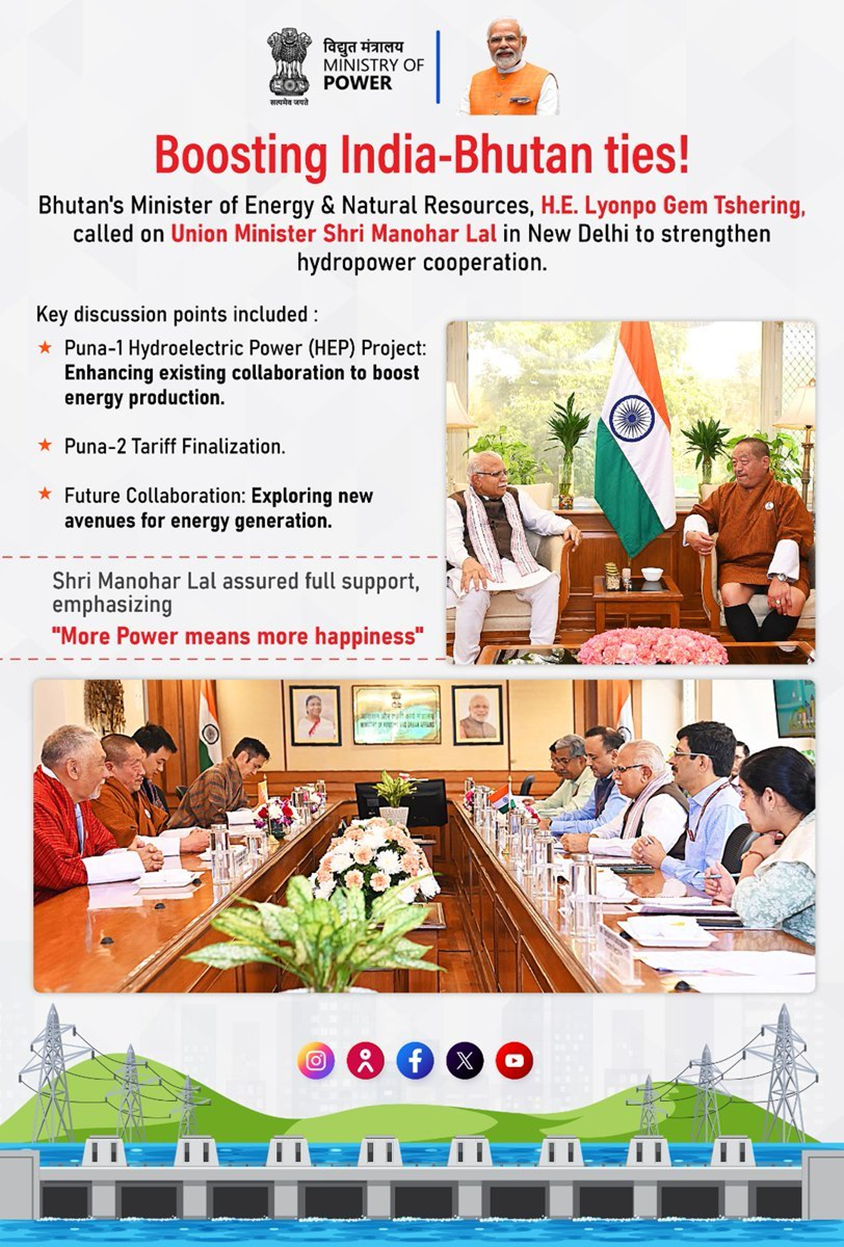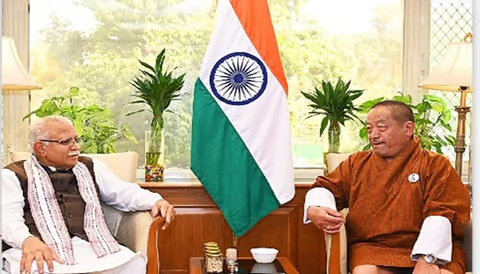Context:
On October 18, 2024, officials from Bhutan and India convened to discuss enhancing their collaboration on the Puna-1 Hydroelectric Power (HEP) Project, aimed at boosting energy production. The meeting also addressed finalizing tariffs for the Puna-2 project, reflecting ongoing efforts to ensure the economic viability of these initiatives. Both nations explored potential avenues for future cooperation in energy generation, underscoring the strategic importance of their partnership.
Significance of Bhutan for India:
· India regards Bhutan as a crucial buffer state between itself and China. Bhutan's location, bordered by China to the north and India to the south, positions it strategically for India, particularly with respect to the Siliguri Corridor, a narrow strip of land connecting India’s northeastern states to the rest of the country. This corridor is vital for the movement of troops and supplies, making Bhutan's allegiance important for India's national security.
· India has historically ensured Bhutan's security by assisting in border management and countering insurgent groups. The Indian military conducts training programs for the Royal Bhutan Army, contributing to the latter's defense capabilities. Furthermore, India’s diplomatic backing has been essential for Bhutan in international engagements, preserving its sovereignty. India and Bhutan share a multifaceted relationship characterized by extensive cooperation across various sectors.
1 Trade: India is Bhutan’s primary trade partner, serving as both its main source of imports and its primary export destination, with a trade balance favoring India. India also leads in foreign investment in Bhutan, accounting for 50% of the country’s total Foreign Direct Investment (FDI).
o The Trade, Commerce, and Transit Agreement (2016) establishes a free trade regime between the two nations, promoting smoother economic exchanges.
2. Development Partnership: Bhutan is the largest beneficiary of India’s external aid, particularly as reflected in India’s 2023-24 budget.
o India supports Bhutan’s goal of achieving high-income status by 2034, with initiatives like ‘Brand Bhutan’ and ‘Bhutan Believe’ aimed at boosting its economic prospects.
3. Connectivity: Plans for Gelephu Mindfulness City, an international city linking Bhutan with Assam, are part of efforts to enhance connectivity and strengthen economic ties.
4. Security Cooperation: The Indian Military Training Team (MTRAT) is stationed in Bhutan, providing assistance and training to the Royal Bhutan Army, strengthening Bhutan's defense capabilities.
o Additionally, India’s Border Road Organisation (BRO) has constructed many of Bhutan's roads through Project DANTAK, improving infrastructure.
5. New Initiatives: India has launched several technological initiatives in Bhutan, including the RuPay and BHIM apps and the ‘Digital Drukyul’ initiative to promote digital payments.
o Space cooperation has also advanced, with ISRO and Bhutan’s space agency jointly developing the ‘India-Bhutan SAT,’ which ISRO successfully launched.
o Furthermore, India is addressing Bhutan’s shortage of STEM teachers and has supported Bhutan’s public health sector through the Vaccine Maitri Initiative, providing 5.5 lakh doses of Covishield.

Hydropower Cooperation:
· Hydropower cooperation serves as the foundation of India-Bhutan economic relations, capitalizing on Bhutan's vast hydropower potential. India benefits significantly from Bhutan’s projects, which contribute to both economies. Major hydropower projects such as Tala, Chukha, and Mangdechhu provide renewable energy to India while significantly contributing to Bhutan's economy, making it one of the highest per capita income countries in South Asia. Hydropower exports form a substantial portion of Bhutan’s national revenue.
· Despite the mutual benefits, challenges have emerged. India has encountered difficulties in hydropower trade due to changes in power purchasing policies, challenges in negotiating fair power tariffs, and delays in completing projects like Punatsangchhu I and II.
· Noteworthy hydropower collaborations include:
§ India’s construction of four major hydroelectric projects in Bhutan: Kurichhu, Tala, Chukha, and Mangdechhu, all of which are essential to Bhutan’s energy sector and provide electricity to India.
§ The 720 MW Mangdechhu project, handed over to Bhutan in 2022, marked a key milestone in their energy collaboration.
Challenges in the India-Bhutan Relationship:
Despite strong cooperation, certain challenges persist:
1. Militant Hideouts: Militant groups from India’s northeast, such as ULFA and NDFB, have used Bhutan as a hideout, complicating security relations.
2. BBIN Initiative Stalemate: The Bangladesh-Bhutan-India-Nepal (BBIN) Motor Vehicle Agreement remains stalled due to Bhutan’s environmental concerns, hindering regional connectivity.
3. Increased Financial Burden: India’s shift from a 60:40 funding model (grant to loan) to a 30:70 model has imposed greater financial pressure on Bhutan, impacting its economic stability.
4. China’s Presence: Bhutan’s border disputes with China, especially over Doklam, pose security concerns for India. China’s increasing influence in the region further complicates India’s strategic interests.
|
China's Rising presence in Bhutan : The geopolitical dynamics of the India-Bhutan-China triangle are complex and influenced by various interrelated factors: 1. China's Rising Influence: China's economic engagement in Bhutan has grown significantly, with Chinese entities accounting for more than a quarter of Bhutan’s trade. · For instance, the Chukha and Punatshangchu hydropower projects. Additionally, Chinese state-owned companies dominate Bhutan's telecom sector, where they are responsible for laying fiber optic cables, expanding mobile networks, and establishing internet access points throughout the country. 2. Territorial Assertiveness: China has made assertive territorial claims over areas such as Jakarlung and Pasamlung in northern Bhutan, as well as the strategically important Doklam plateau. · This assertiveness is exemplified by the construction of a new village, Pangda, near Doklam, and China's recent claim to 650 sq. km of the Sakteng Wildlife Sanctuary in Bhutan’s eastern district of Trashigang. 3. Political Maneuvering: October 2023 marked the first-ever visit of Bhutan's Foreign Minister to China, despite the lack of formal diplomatic relations between the two countries. This visit resulted in the signing of a cooperation agreement for boundary delimitation and demarcation, indicating a potential normalization of relations between Bhutan and China. Implications for India
1. Threat to India’s Security Interests: The Bhutan-China border deal may have significant security implications for India due to its proximity to the Siliguri Corridor, which is crucial for India’s northeastern states. 2. Geopolitical Implications: China's increased presence in Bhutan could disrupt the regional geopolitical balance and dynamics, potentially heightening tensions between India and China. 3. Erosion of India's Influence: Close ties between Bhutan and China can impact Bhutan's traditional pro-India foreign policy, posing challenges to India’s influence in the region. |
Conclusion:
As India navigates the evolving geopolitical landscape in Bhutan, characterized by China’s increasing influence, it must leverage its historical ties and strengthen cooperation in key areas. The future of India-Bhutan relations will largely depend on how both countries address the challenges posed by external influences while fostering their longstanding partnership rooted in mutual respect and cooperation. The outcome of Bhutan's foreign policy choices will significantly impact the strategic equilibrium in the region, necessitating proactive engagement and diplomatic efforts from India to secure its interests and maintain stability in South Asia.
|
Probable Questions for UPSC Mains Exam: Examine the significance of Bhutan in India’s geopolitical strategy, especially in the context of rising Chinese influence in the region. Discuss how Bhutan's position impacts India’s national security, particularly concerning the Siliguri Corridor. |







